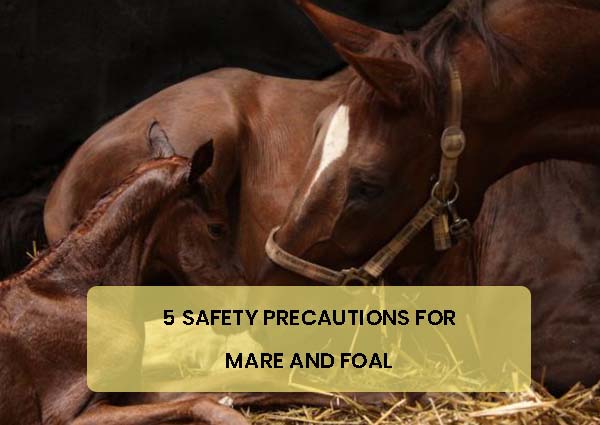5 safety precautions for mare and foal
5 safety precautions for mare and foal
If you’ve ever been involved in mare breeding, then you already know how much hard work, time and energy is actually put into making sure that each and every broodmare births a healthy foal. In most cases, a considerable amount of cash has been spent on breeding and stud fees, veterinary expenses and a high quality nutrition program. In addition, each and every mare is carefully monitored daily, as those involved patiently wait almost a complete year for the arrival of the foal. How can you make sure that your mare, continues to stay happy and balanced so that she can raise a healthy foal?
Maintain the recommended vaccination and deworming schedules.
The newborn foal actually derives his immediate immunity from the mare’s colostrum, which suggests that keeping her up to date on vaccinations is quite imperative for the health of both mare as well as the foal. You will already be vaccinating the mare throughout her pregnancy, but one month before foaling, the mare should receive additional vaccinations. Recommendations may vary by region, so be sure to actually discuss them together with your vet before time. Likewise, you’ve already been following deworming protocols, but pregnant mares should also be dewormed again, both before and a couple of days after foaling to reduce the danger of parasite transmission. Speak to your veterinarian to establish a plan that’s right for you and your breeding operation.

Prepare the foaling stall.
Move your mare into her foaling stall 4 to six weeks before her due date. If your broodmare has been living the high life out on pasture, give her lots of time to adjust to her new environment to minimize stress. The foaling stall should be a minimum of 14’ x 14’ and will be clean and protected from inclement weather. The foaling stall should be bedded with straw 1 to 2 days before the due date (or when the mare is showing signs of impending foaling). Straw is actually the ideal bedding choice for foaling since shavings are abrasive and might sometimes be sucked into the mare’s reproductive tract during birth, which can lead to uterine infections and other problems. Once the birth process is finished, transitioning back to shavings is quite acceptable and is usually beneficial for increased absorption of urine.
Select Your Poultry Industry
Poultry farming is a complex business. There are two forms of poultry farming: broilers and layers. Broilers are birds that produce meat. Layers are birds that are kept only for the purpose of laying eggs. There’s also the matter of hatching eggs and caring for chicks to consider.
Focus on nutrition.
Not only do nutrient requirements increase during a mare’s 3rd trimester, but they’re also at their highest ever during lactation. To maintain the mare’s body condition and prepare her digestive tract for lactation, slowly and safely begin to increase her feed during the end of the 2nd trimester or at the beginning of the third trimester. It is best to work with an equine nutritionist and veterinarian to make sure that your mare is receiving the suitable levels of all required nutrients, including minerals and vitamins, which are vital for growing horses, too. Furthermore, during the last trimester and after foaling, the mare goes through many more changes than usual. She is usually moved to a new living situation, traveling to the vet, must give birth and is ultimately caring for a newborn foal. These changes are undoubtedly stressful and should negatively impact her gut microbiome. Watch for any signs of colic in pregnant mares and consider supplementing with research-backed probiotics to shield your mare and mitigate any potential trouble.
Monitor the mare closely.
Once the mare has been safety moved into a foaling stall, you need to hone your observation skills. While each mare is different, they often display signs before foaling, including: Waxing of the teats (say about 1-4 days before foaling) The udder area filling with milk (about 2-4 weeks before foaling) Relaxation of the vulva as well as tail-head Restlessness or anxiousness Pacing Lying down and then getting back up excessively or quite often While there are always surprises, most mares will exhibit one or more of such signs. It is best to be present for the birth of the foal just in case complications arise, so monitor as closely as possible. You may also consider investing during a foaling monitor to help you.
Make sure the newborn foal receives the correct colostrum levels.
Once the foal is born, the 1st 24 hours of life are critically important to future health and wellness. Foals aren’t born with a functioning immune system and need immediate immune assistance from the mare’s colostrum, or the 1st milk. A foal’s digestive tract is merely able to absorb the life-saving antibodies from colostrum for the first 8 to 12 hours after birth. If any issues arise with nursing, like the mare not producing adequate colostrum or the foal being unable to nurse, contact your veterinarian as soon as possible, as failure of passive transfer can be fatal. Luckily, most broodmares foal without complications, even as nature intended. However, these five safety precautions will assist you support your mare and foal during these vulnerable stages of their lives. And remember, supporting your mare’s gut health can help prevent digestive complications related to stress. That way, your mare can focus on her most vital job at this time: raising a healthy foal.
